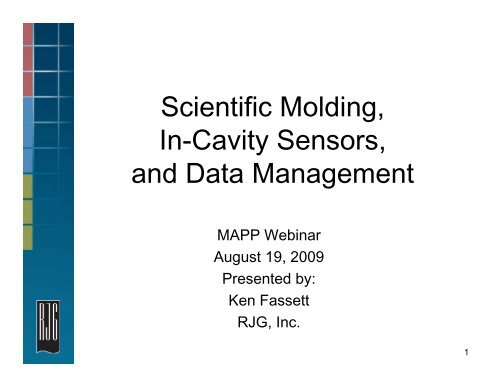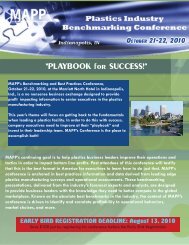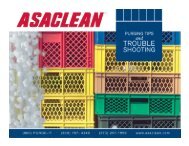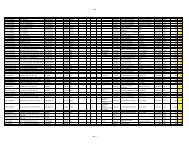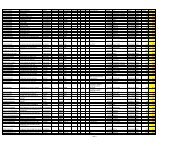Scientific Molding, In-Cavity Sensors, and Data Management - MAPP
Scientific Molding, In-Cavity Sensors, and Data Management - MAPP
Scientific Molding, In-Cavity Sensors, and Data Management - MAPP
Create successful ePaper yourself
Turn your PDF publications into a flip-book with our unique Google optimized e-Paper software.
<strong>Scientific</strong> <strong>Molding</strong>,<br />
<strong>In</strong>-<strong>Cavity</strong> <strong>Sensors</strong>,<br />
<strong>and</strong> <strong>Data</strong> <strong>Management</strong><br />
<strong>MAPP</strong> Webinar<br />
August 19, 2009<br />
Presented by:<br />
Ken Fassett<br />
RJG, <strong>In</strong>c.<br />
1
What is <strong>Scientific</strong> <strong>Molding</strong>?<br />
You can know the name of a bird in all the<br />
languages of the world, but when you’re<br />
finished, you’ll know absolutely nothing whatever<br />
about the bird… So let’s look at the bird <strong>and</strong> see<br />
what it’s doing - - that’s what counts…<br />
Richard Feynman<br />
US Educator & Physicist<br />
2
Why is<br />
<strong>Scientific</strong> <strong>Molding</strong><br />
Important?<br />
3
One Word<br />
Competition<br />
4
Knowledge is the Only<br />
Sustainable Competitive Advantage<br />
5
Patents Are NOT!<br />
The best offence is a good defense, right<br />
…where could gas assist technology be today?<br />
6
Closed Borders are NOT!<br />
Ask me about a certain injection<br />
molding industry in Europe…<br />
7
Technology is NOT!<br />
Utilization of technology may be…<br />
which is knowledge based!<br />
8
The best technology in the world,<br />
whether from Germany, or Japan, or the US,<br />
is available for purchase in low-cost labor countries<br />
AND THEY CAN AFFORD IT!<br />
9
“Is it better for the trained people to leave<br />
or the untrained people to stay?”<br />
10
Therefore, their cost of quality is HUGE!<br />
11
Knowledge is OUR only<br />
Sustainable Competitive Advantage<br />
12
<strong>Scientific</strong> <strong>Molding</strong><br />
•>2,500 people from the US IM industry have gone through<br />
an RJG 3 day <strong>Scientific</strong> <strong>Molding</strong> seminar since 1991<br />
•>1200 people from the US IM industry have gone through<br />
an RJG 10 day <strong>Scientific</strong> <strong>Molding</strong> h<strong>and</strong>s-on course since<br />
1999<br />
13
Knowledge<br />
• A Constant Pursuit<br />
• Buy it, or <strong>In</strong>vest in it<br />
14
Why is<br />
<strong>Scientific</strong> <strong>Molding</strong><br />
Important?<br />
15
The Wall of Shame<br />
‣ Short Shots<br />
‣ Sink <strong>and</strong> voids<br />
‣ Dimensional Variations<br />
‣ Warp<br />
‣ Flash<br />
Cosmetic rejects like:<br />
Splay<br />
Specs<br />
Off color<br />
Are not generally process control related problems<br />
16
Not So <strong>In</strong>dependent Variables in <strong>In</strong>jection <strong>Molding</strong><br />
Screw<br />
Run Time<br />
Material<br />
Properties<br />
Backpressure<br />
Drying<br />
Material<br />
Supplied<br />
Colorant or<br />
other additives<br />
Shot Size<br />
Items in rounded rectangles are<br />
equipment setup parameters<br />
Transfer Position or<br />
<strong>Cavity</strong> Pr. Setpoint<br />
Fill ->Pack Position<br />
Pack Speed<br />
Hold Pressure<br />
Plastication Rate<br />
(i.e. screw RPM)<br />
Melt<br />
Temperature<br />
Viscosity<br />
Pressure<br />
Profile<br />
Barrel<br />
Temperatures<br />
Hot Runner<br />
Variation<br />
Flow Rate<br />
Coolant<br />
<strong>In</strong>let<br />
Pressure<br />
Cooling<br />
Channel<br />
Condition<br />
Coolant<br />
Outlet<br />
Pressure<br />
Melt temperature affects<br />
both cooling rate <strong>and</strong> mold<br />
surface temperature<br />
Coolant<br />
Flow Rate<br />
Coolant<br />
Delta<br />
Pressure<br />
Check Ring<br />
Performance<br />
Cooling<br />
Mold<br />
Temperature<br />
Speed<br />
Settings<br />
Coolant<br />
Temperature<br />
Cooling Time<br />
(Mold Clamped time)<br />
Times: Cycle,<br />
Mold Open etc.<br />
<strong>Cavity</strong><br />
Shape<br />
(deflection)<br />
9/5/07<br />
Art Schubert<br />
© 2007 RJG <strong>In</strong>c.<br />
17
• Material Viscosity Variation<br />
– Velocity induced<br />
– <strong>In</strong>herent<br />
• Imbalance<br />
• Pressure Loss<br />
• Machine (IN)Dependence<br />
– Pressure vs. <strong>In</strong>tensification Ratios<br />
– Linear Shot Measurement vs. cavity volume<br />
18
Material Variation Over Time<br />
Expect at Least a<br />
20% viscosity Variation<br />
This Is Normal<br />
19
If You have:<br />
Hold On Tight<br />
• New Machines<br />
• New Molds<br />
• Virgin Plastic (with a 20% normal<br />
viscosity variation over time)<br />
• Automatic Cycle<br />
• Air Conditioned <strong>Molding</strong> Rooms<br />
The best you can expect is that<br />
cavity pressure will vary just<br />
under ________%???<br />
Underst<strong>and</strong>ing why is key to<br />
developing a robust Automated<br />
process control strategy!<br />
20
What is <strong>Scientific</strong> <strong>Molding</strong>?<br />
You can know the name of a bird in all the<br />
languages of the world, but when you’re<br />
finished, you’ll know absolutely nothing whatever<br />
about the bird… So let’s look at the bird <strong>and</strong><br />
see what it’s doing - - that’s what counts…<br />
Richard Feynman<br />
US Educator & Physicist<br />
22
A Strategy Based on the<br />
4 Plastics’ Variables<br />
“Helps <strong>In</strong>jection Molders Succeed”<br />
<br />
Temperature<br />
<br />
Flow Rate<br />
<br />
Pressure<br />
<br />
Cooling<br />
23
A Concept - Using <strong>Data</strong> to Verify<br />
Process Parameter<br />
Shot<br />
Fill Time<br />
Plastic<br />
Pressure<br />
1/t<br />
Effective<br />
Viscosity<br />
30000<br />
1 0.20 8720<br />
5.0 1,744<br />
27000<br />
10<br />
2 0.22 8160<br />
4.55 1,795<br />
24000<br />
3 0.30 5440<br />
4 0.62 4640<br />
3.33 1,632<br />
1.61 2,877<br />
21000<br />
9<br />
5 1.47 2969<br />
.68 4,364<br />
18000<br />
8<br />
6 1.52 2960<br />
7 1.92 6260<br />
.65 4,499<br />
.52 12,019<br />
15000<br />
8 2.13 8160<br />
.47 17,381<br />
12000<br />
7<br />
9 2.52 8560<br />
10 3.31 8360<br />
.40 21,571<br />
.30 27,672<br />
9000<br />
6000<br />
6<br />
5<br />
3000<br />
4<br />
3<br />
2<br />
1<br />
5.0<br />
4.5<br />
4.0<br />
3.5<br />
3.0<br />
2.5<br />
2.0<br />
1.5<br />
1.0<br />
.50<br />
24
Analyzing Plastic Viscosity<br />
<strong>In</strong>tegral data can be broken down into fundamental parts such as the<br />
integral during fill.<br />
The area under the hydraulic pressure curve during fill represents the<br />
sum of the resistance to flow during fill <strong>and</strong>, therefore, represents the<br />
viscosity of the plastic.<br />
Effective Viscosity or Fill <strong>In</strong>tegral<br />
PRESSURE (PSI)<br />
Fill<br />
Plastic<br />
<strong>In</strong>jection<br />
Pressure<br />
Pack & Hold<br />
0<br />
Start Mold<br />
Fill Time<br />
TIME (SECONDS) 16<br />
25
Systematic Approach<br />
26<br />
1.Part Design<br />
2.Gate & Runner Balance<br />
3.Press Selection<br />
4.Process Development
Part Design<br />
High Risk Part Design<br />
Square corners equals risk of 5<br />
Additions to walls equals risk of 5<br />
Change in wall thickness equals risk of 5 if<br />
gate location is on opposing end of part<br />
Low Risk Part Design<br />
Square corners equals risk of 2<br />
Additions to walls equals risk of 5<br />
Change in wall thickness equals risk of 3<br />
27
Part of process control involves knowing if <strong>and</strong> when gate<br />
seal occurs on all cavities for all molds.<br />
Without <strong>In</strong>strumentation<br />
we use part weight study<br />
With instrumentation we use post<br />
gate psi curve including hold time<br />
Gate Seal = Best Dimensional Control<br />
Allowing discharge or backflow out of the gate after a set period of time:<br />
‣ Can reduce compressive stresses near the gate<br />
‣ Can affect pressure gradient caused warpage<br />
28
Pressure Loss Study<br />
15,256 ppsi<br />
9,628 ppsi<br />
8,343 ppsi<br />
What happens if the<br />
viscosity changes?<br />
5,245ppsi<br />
29
<strong>In</strong>tensification Ratio<br />
Not Enough<br />
Pressure<br />
30
Mold Transfer<br />
Machine A<br />
Machine B<br />
220 ton clamp force<br />
‣ 2600 psi hydraulic pump<br />
‣ General Purpose Screw<br />
‣ 12 inch linear shot capability<br />
‣ Maximum <strong>In</strong>jection Speed 10.2 in/sec<br />
‣ Tie Bar Spacing is 17in x 17in<br />
‣ 1.78 in diameter screw<br />
‣ 12.2:1 <strong>In</strong>tensification Ratio<br />
220 ton clamp force<br />
‣ 2600 psi hydraulic pump<br />
‣ General Purpose Screw<br />
‣ 12 inch linear shot capability<br />
‣ Maximum <strong>In</strong>jection Speed 10.2 in/sec<br />
‣ Tie Bar Spacing is 17in x 17in<br />
‣ 2.25 in diameter screw<br />
‣ 9.85:1 <strong>In</strong>tensification Ratio<br />
31
Machine Dependent<br />
Machine A<br />
750 psih<br />
Machine B<br />
32
Machine Dependent<br />
9,150 ppsi<br />
Machine A<br />
750 psih<br />
7,388 ppsi<br />
Machine B<br />
33
Machine INDEPENDENT<br />
Hold Pressure<br />
Machine A Plastic Machine B<br />
750 psi h<br />
9,150 ppsi 929 psi h<br />
Settings<br />
R I : 9.85:1<br />
Screw Dia: 2.25”<br />
R I : 12.2:1<br />
Screw Dia: 1.78”<br />
34
<strong>In</strong>tensification Ratio<br />
Machine A<br />
750 psih<br />
9,150 ppsi<br />
Machine B<br />
929 psih<br />
35
What about VOLUME of Plastic?<br />
Machine A<br />
R I : 12.2:1<br />
Screw Dia: 1.78”<br />
Plastic<br />
Settings<br />
Machine B<br />
R I : 9.85:1<br />
Screw Dia: 2.25”<br />
Transfer Position<br />
1.855 in.<br />
4.617 in 3<br />
1.161 in.<br />
36
Plastic Temperature<br />
Plastic Temp<br />
Machine A<br />
Barrel Temp<br />
Zone 1-4<br />
475<br />
Plastic<br />
Settings<br />
Melt Temp<br />
460<br />
Machine B<br />
Barrel Temp<br />
Zone 1-4<br />
482<br />
37
Cooling<br />
Mold Surface Temp<br />
Machine A<br />
Thermolator<br />
Setting<br />
148<br />
Plastic<br />
Settings<br />
Steel Surface<br />
145<br />
Machine B<br />
Thermolator<br />
Setting<br />
150<br />
38
Matching Using <strong>Data</strong><br />
39
And for the Toughest Jobs...<br />
<strong>Cavity</strong><br />
Pressure<br />
Probably no more than 20% of molds<br />
40
Monitoring <strong>and</strong> Containment<br />
For Process Control<br />
The Goal:<br />
‣ No escapes of bad parts to the<br />
downstream customer<br />
41
Successful Molders<br />
Now Realize That:<br />
What Happens in the <strong>Cavity</strong><br />
Stays in the Part<br />
42
The Problem<br />
“Bad” parts get sent downstream<br />
to the customer:<br />
‣ Short Shots<br />
‣ Sink <strong>and</strong> voids<br />
‣ Dimensional Variations<br />
‣ Warp<br />
‣ Flash<br />
Bad = Other than Normal<br />
43
Critical Containment Applications<br />
Here’s the 20%<br />
‣ Monitor <strong>Cavity</strong> Pressure on high volume <strong>and</strong> high<br />
problem jobs<br />
• End of <strong>Cavity</strong> to detect <strong>and</strong> contain short shots <strong>and</strong> observe<br />
variation<br />
• Gate end to detect gate seal <strong>and</strong> detect variation over the<br />
entire part<br />
Use Alarm light tree or Alert to warn of problems<br />
Contain abnormal parts<br />
This is the start of Process Monitoring <strong>and</strong><br />
Control from the Plastics’ Point of View<br />
44
Abnormal Part Containment<br />
45
You Can’t Manually Sort Your Way To<br />
World Class<br />
‣ 4 sigma companies can produce 6 sigma products<br />
through enormous amounts of rework<br />
‣ They can’t raise their prices to recapture their costs<br />
because they must price their products<br />
competitively<br />
‣ Business quality is highest when cost is at its<br />
absolute lowest for both the producer <strong>and</strong> the<br />
consumer<br />
46
Constant Machine Conditions:<br />
Are the parts the same?<br />
REMEMBER: What happens in the cavity stays in the part!<br />
47
Which Do We Watch?<br />
‣ <strong>Cavity</strong> Pressures:<br />
• <strong>In</strong>tegrals are usually best<br />
‣ Mold Surface Temperatures Semi-Crystalline Aps<br />
• Cooling temperature <strong>and</strong> time<br />
• Effective Melt Temp<br />
• Can be used for full cavity monitoring in<br />
high cavitation mold<br />
‣ Material Condition:<br />
• Effective Viscosity<br />
This is Process Control from the<br />
Plastic’s Point of View using containment<br />
It’s The Best!<br />
48
<strong>In</strong> Mold Gate End Pressure<br />
20,000<br />
PRESSURE (PSI)<br />
Peak PSI<br />
• Fill Dynamics<br />
• Correct Transfer<br />
• Pack Rate/Time<br />
• Peak PSI<br />
• Static Pressure Gradient<br />
• Cooling<br />
• Gate Seal<br />
• Best For Control<br />
Pack Rate<br />
Cooling Rate<br />
Area or<br />
<strong>In</strong>tegral<br />
Reduction due<br />
to Discharge<br />
0<br />
Full<br />
Packed<br />
TIME (SECONDS) 15<br />
49
<strong>In</strong> Mold End of <strong>Cavity</strong> Pressure<br />
20,000<br />
PRESSURE (PSI)<br />
Peak PSI<br />
• Full Part<br />
• Pack Rate/Time<br />
• Peak PSI<br />
• Cooling<br />
• Most Variable<br />
• Best For Monitoring<br />
No Dynamic PSI<br />
Pack Rate<br />
Cooling Rate<br />
0<br />
TIME (SECONDS) 15<br />
50
The Opportunity<br />
51
Relate Directly to Pressure Variation<br />
in the <strong>Cavity</strong>!<br />
‣ Short Shots<br />
‣ Sink <strong>and</strong> voids<br />
‣ Dimensional Variations<br />
‣ Warp<br />
‣ Flash<br />
52
Correlate Your <strong>Data</strong> To Part Quality<br />
29,341<br />
29,723<br />
30,642<br />
31,325<br />
32,445<br />
32,889<br />
33,021<br />
34,555<br />
<strong>Cavity</strong> Pressure<br />
Cycle <strong>In</strong>tegral<br />
48.010<br />
48.025<br />
48.040<br />
48.055<br />
48.070<br />
48.085<br />
48.100<br />
48.115<br />
Dimensions<br />
Looks<br />
Good<br />
53
Auto Alarm Capability<br />
Sample groups can be collected<br />
in the eDART TM Software.<br />
54
Auto Alarm Capability<br />
Automatically correlate data collected by the<br />
eDART System TM to your critical part attributes<br />
55
Close the Loop<br />
56
The Value of <strong>Data</strong><br />
Viscosity<br />
<strong>Cavity</strong><br />
pressure<br />
Can SQC find the 4 bad parts??<br />
57
<strong>Data</strong> Taken Over Time is effective for<br />
Process Monitoring / Abnormal<br />
Cycle Detection<br />
Know<br />
Immediately<br />
when<br />
something<br />
has changed<br />
58
<strong>Data</strong> <strong>Management</strong><br />
59
This?<br />
Or this?<br />
60
Why would we want to guess what is going<br />
on when we can see – with data?…<br />
61
Which Machine Process<br />
is Set-up Correctly?<br />
62
Which Machine Process<br />
is Set-up Correctly?<br />
Correct Set-Up<br />
<strong>In</strong>correct Set-Up<br />
63
The Match Meter<br />
‣ <strong>In</strong> a glance see if the process is set up correctly<br />
‣ See if the viscosity has changed<br />
64
How do you determine whether<br />
ALL OF YOUR MACHINES AND<br />
PROCESSES<br />
are set up correctly?<br />
65
All the Machine Meters<br />
on One page<br />
66
Advanced System Overview<br />
67
How was your plant running<br />
LAST NIGHT?<br />
68
ASO History<br />
69
Check out the problem with a press<br />
without leaving your desk!<br />
70
ASO Process Viewer<br />
71
But what did the data look like back<br />
when the Machine Match went into the red?<br />
72
Analyzer Mode<br />
73
When problems occur,<br />
how do you know what happened?<br />
The data is stored on the eDART!<br />
74
What is Your<br />
Quality Accountability?<br />
75
So, when you want to know how<br />
your plant is running,<br />
what data do you want to rely on?<br />
76
This?<br />
Or this?<br />
77
<strong>Data</strong> <strong>Management</strong>: The Goal<br />
‣ To Know What You Don’t Know<br />
• <strong>In</strong>termittent Process Variation<br />
• Breakdowns<br />
• Bad set ups<br />
• Bad material<br />
<br />
<br />
Dryness<br />
Viscosity<br />
78
Systematic Approach<br />
79<br />
1.<strong>Scientific</strong> <strong>Molding</strong><br />
2.<strong>Cavity</strong> Pressure Technology<br />
3.<strong>Data</strong> <strong>Management</strong>
How RJG Can Help<br />
Full Service Provider for <strong>In</strong>jection Molders<br />
Training<br />
‣Seminars<br />
‣Master Molder Certification<br />
‣H<strong>and</strong>s On Workshops<br />
Process Monitoring/Control<br />
‣ Machine<br />
‣ <strong>Cavity</strong> Pressure<br />
80
Make It Happen!<br />
The greatest difference between those that have<br />
done a lot <strong>and</strong> those that accomplish little:<br />
High achievers set specific timetables to accomplish<br />
seemingly impossible tasks <strong>and</strong> routinely meet or<br />
exceeded them.<br />
81<br />
July 20, 1969
Let us help you in your<br />
Transformation Process!<br />
82
At RJG,<br />
in all that we teach <strong>and</strong><br />
in all that we do,<br />
our mission is..<br />
Helping<br />
<strong>In</strong>jection Molders<br />
Succeed<br />
www.rjginc.com<br />
83


